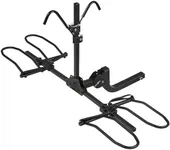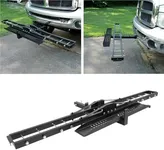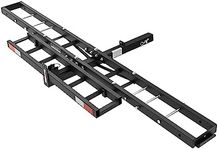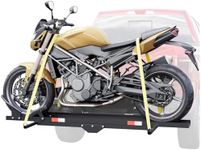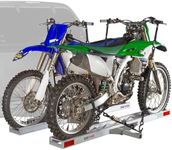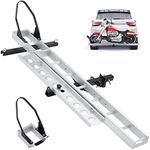Buying Guide for the Best Dirt Bike Hitch Carriers
Choosing a dirt bike hitch carrier is all about making sure you can safely and easily transport your bike using your vehicle’s hitch receiver. The right carrier will keep your bike secure, be easy to load and unload, and match your vehicle’s capabilities. Before you start shopping, think about your bike’s weight, your vehicle’s towing capacity, and how often you’ll be using the carrier. Understanding the key features will help you pick a carrier that fits your needs and keeps your bike safe on the road.Weight CapacityWeight capacity refers to the maximum weight the carrier can safely hold. This is crucial because if your dirt bike is heavier than what the carrier can handle, it could lead to damage or unsafe driving conditions. Carriers are usually divided into light-duty (up to 300 lbs), medium-duty (300-500 lbs), and heavy-duty (over 500 lbs). To pick the right one, check your dirt bike’s weight and choose a carrier that can handle a bit more than that for extra safety.
Hitch Receiver SizeThe hitch receiver size is the dimension of the opening on your vehicle where the carrier attaches. The most common sizes are 1.25-inch and 2-inch receivers. Larger vehicles like trucks and SUVs usually have 2-inch receivers, which can handle heavier loads. Make sure the carrier you choose matches your vehicle’s hitch size, or you’ll need an adapter, which can sometimes reduce stability.
Material and Build QualityMaterial and build quality determine how durable and long-lasting the carrier will be. Most carriers are made from steel or aluminum. Steel is stronger and better for heavy bikes, but it’s heavier and can rust if not coated. Aluminum is lighter and rust-resistant, making it easier to handle but sometimes less sturdy for very heavy bikes. Choose based on how much weight you need to carry and how often you’ll be loading and unloading the carrier.
Ramp DesignRamp design refers to how you load your bike onto the carrier. Some carriers have built-in folding ramps, while others have detachable ramps. Longer ramps make loading easier, especially for heavier bikes, but can be bulkier to store. If you’ll be loading the bike by yourself or have a heavier bike, look for a carrier with a longer, sturdy ramp.
Security FeaturesSecurity features include things like tie-down points, anti-tilt devices, and locking mechanisms. These features keep your bike stable and secure during transport. More tie-down points give you flexibility in securing your bike, while anti-tilt devices reduce wobbling. If you’ll be leaving your bike unattended, look for carriers with locking options for extra peace of mind.
Carrier Width and Track SizeCarrier width and track size refer to the part of the carrier where your bike’s tires sit. It’s important that the track is wide enough for your bike’s tires but not so wide that the bike moves around. Tracks are usually divided into standard (for most dirt bikes) and wide (for fat-tire or adventure bikes). Measure your bike’s tires and make sure the carrier’s track will fit them snugly.
